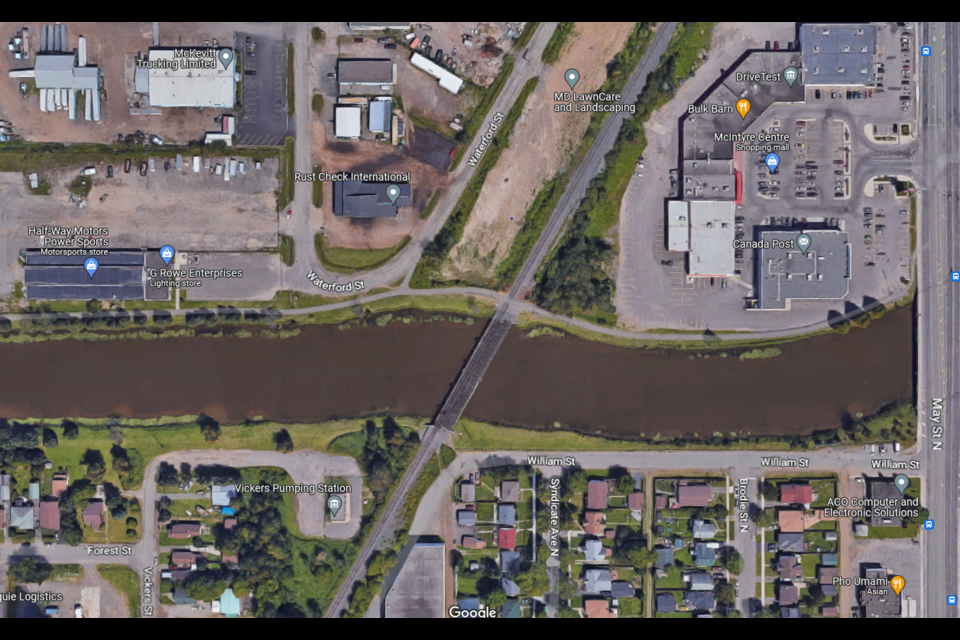THUNDER BAY — A crucial piece of a planned cycling route connecting Thunder Bay’s north and south ends could be in place as soon as 2024, after years of setbacks.
The Vickers-Carrick bridge, long identified as a top priority in the city’s active transportation plans, will be designed this year thanks to a $170,000 commitment in the recently-approved city budget.
The budget also forecasts $2.5 million in spending next year to build the bridge, which would carry pedestrian and cycling traffic across the Neebing-McIntyre floodway just a few hundred metres west of May Street.
Cycling advocate Ken Shields said it’s a welcome move that helps answer decades of calls to build a safe, direct north-south bike route.
That route would enable efficient bike trips across the city and open up the intercity area to cyclists of all ages and abilities, he said.
“It’s important to the city. The area there is pretty much only accessible by motor vehicles safely. You’ll find cyclists bravely on the street, but not with their children.”
“We need to get [cycling routes] closer and closer to the intercity area, so folks can go to work, go to restaurants, shopping, the cinema, the farmer’s market.”
Shields emphasizes there remains plenty more work to make the north-south route a reality after the bridge is built. And given previous setbacks, he’s waiting to see that council follows through next year.
Those concerns were reinforced by a failed last-minute push by Coun. Brian Hamilton to pull the funds for design work from this year’s budget shortly before it was approved on Monday. Hamilton proposed reallocating the dollars to other active transportation projects.
“This is a highly valued piece of infrastructure, but … we have a lot of competing priorities,” he said. “It's my hope we pump the brakes a little bit on the bridge project until we’ve identified priority needs for infrastructure.”
That drew sharp retorts from some colleagues, who questioned why the same argument wasn’t applied to other infrastructure projects in the budget.
“To say ‘pump the brakes’ on this would have got the old Shelby quite upset, but you know — new year, new me,” said Coun. Shelby Ch’ng. “This has been on the books since 2015 — eight years.”
Hamilton’s motion came “at the 11th hour,” Ch’ng added, after opportunities for public input on budget decisions had passed.
The dominant theme in pre-budget feedback had been calls to invest in active transportation.
"I don’t know what else I can tell the active transportation community," said Ch'ng. "I don’t know how I can go to them now and say, your voice is being heard, when this is so obviously being derailed."
Coun. Andrew Foulds agreed.
“To be perfectly frank, this has been already pushed off for how many years?” he said. “The argument that’s just been put forward [was] put forward five years ago — maybe even more.
“As we push these things off, guess what? They get more expensive.”
Coun. Mark Bentz defended Hamilton’s proposal.
“This is a sober second look at what we’re going to do,” he said. “[Hamilton] isn’t trying to derail any project. He’s basically saying to council, look, you have Victoriaville, Red River Road, indoor turf, the police station, the waterfront trail, the conservatory, this bridge, and who knows what else.
“How are we going to pay for that? I’d love to know. This is hundreds of millions of dollars’ worth of infrastructure we need to have a plan for.”
City manager Norm Gale agreed council hasn’t considered competing infrastructure priorities “in a holistic way,” adding administration is working to develop that approach.
The Vickers-Carrick route is identified in the city’s active transportation plan as a medium-term option, with a separated bike lane along Memorial the ultimate goal.
The bridge is just one part of the Vickers-Carrick cycling route, and the city has no timeline yet to complete other portions.
That includes adding bike lanes along Carrick, and building a path from the north end of Carrick along the city’s “Hillyard lands” off of Central Avenue, which currently host an off-leash dog park.
Still, the bridge resolves what city project engineer Mike Vogrig calls the key challenge for a north-south cycling route — crossing the floodway.
“The floodway is obviously a super important piece of infrastructure for the city to help with flooding, so whenever we can, we try not to do any sort of work that might affect its function and capacity,” Vogrig said.
A previous environmental assessment found because of soft soils, pilings for the bridge would need to be driven deep into the ground, potentially disrupting a trunk sewer line located near the bank, and creating $800,000 in additional costs.
To avoid that, the city plans to seek the permission from the Lakehead Region Conservation Authority to build a pier in the middle of the floodway to support the bridge.
“If they feel that jeopardizes the floodway, we’d have to do some deep foundation work on the bank, then we’d have to start looking at doing some reinforcement of the infrastructure underground and monitoring it, to make sure we’re not going to impact it,” said Vogrig.
The city first approached CN Rail, proposing to use its nearby railway bridge, but was refused. The company wants to keep options open to add a second set of tracks on the bridge in the future, Vogrig said.
It’s illegal for pedestrians to cross the bridge, though it remains a commonly-used crossing.
